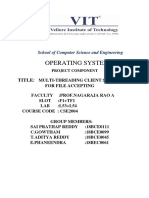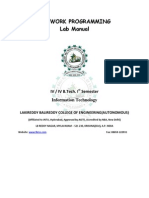Ldap 1
Ldap 1
Uploaded by
Dilpreet SinghCopyright:
Available Formats
Ldap 1
Ldap 1
Uploaded by
Dilpreet SinghOriginal Title
Copyright
Available Formats
Share this document
Did you find this document useful?
Is this content inappropriate?
Copyright:
Available Formats
Ldap 1
Ldap 1
Uploaded by
Dilpreet SinghCopyright:
Available Formats
Assignment Cover Sheet
Unit Co-ord./Lecturer Seyed Beheshti
Tutor:(if applicable) Seyed Beheshti
Student ID MIT151914
Student Name Dilpreet Singh
Unit Code
MN 504
Unit Name Network Application Management
Assignment
Network Application Protocols/ Assignment 1
Title/Number
Word Count
I declare that all material in this assignment is my own work except where there is clear acknowledgement or reference to
the work of others and I have complied and agreed to the University statement on Plagiarism and Academic Integrity on the
University.
Signed
Dilpreet Singh
Date
*By submitting this assignment and cover sheet electronically, in whatever form, you are deemed to have made the declaration
set out above.
Assessors feedback:
Assessment:
Assessors Signature (optional) :
Dated:
Unit code and title: MN504/Network App Management
Your name: Dilpreet Singh (MIT151914)
Assignment 1
Contents
1.
2.
3.
4.
5.
6.
7.
8.
Introduction to Project
Introduction to LDAP
Working of LDAP/ Architecture ..
Protocol Model
Analysis Tool (Wireshark)..
Advantages of LDAP
Disadvantages of LDAP..
Traffic Analysis..
a. RTT..
b. Protocol Hierarchy statistics .
c. Throughput.
d. Service Response Time Statistics
e. Flow Graph
f. Windows Scaling
9. Comparison
10. Conclusion.
11. References..
1. Introduction to Project
Throughout the course, different network management and traffic analysis tasks has
been performed. This assignment is also relating to analysing the traffic for various
protocols. Here, some practical details of NFS (Network File Sharing) protocol, LDAP
(Lightweight Directory Access Protocol) will be discussed. The further discussion then
Page 2 of 13
Unit code and title: MN504/Network App Management
Your name: Dilpreet Singh (MIT151914)
Assignment 1
focuses on the various strengths and weaknesses, how protocol works, its traffic analysis
moreover, the quality of service (QoS).
Finally, a comparison of same protocol with different time frame and different
bandwidth will be performed.
2. Introduction to LDAP
Lightweight Directory Access Protocol (LDAP) is a customer/server convention used to
get to and oversee index data. It peruses and alters catalogues over IP systems and runs
specifically over TCP/IP utilizing straightforward string groups for information
exchange. It was initially created as a front end to X.500 Directory Access Protocol.
Lightweight Directory Access Protocol is otherwise IETF standard called RFC 4510 [1].
(LDAP) characterizes a system representation of a pursuit channel transmitted to a
LDAP server. Fundamentally, when a customer needs to find data on a LDAP server,
certain naming traditions are polished that take into account the area of certain data
inside specific organizers on a server. LDAP works rather correspondingly to the way
DNS works, and the level of unpredictability is generally the same. Windows servers
commonly interlace Active Directory with LDAP, and to the extent Windows items are
concerned, the level of granularity and prohibitive access to clients is genuinely hearty.
In any case, the reason here is opportunity, and a characteristic expansion of that is
moderateness.
Luckily for the ambitious framework head, LDAP is not an exclusive standard, so the
naming traditions from stage to stage will remain generally the same. Besides, most
current Linux appropriations offer their own particular rendition of a LDAP customer,
which ought to take into account a smoother usage in the endeavour. Along these lines,
for the individuals prepared to start into the domain of OpenLDAP, they require just
download the open-source programming, and start the installation (Brad Casey, March
29, 2013).
3. How LDAP works/ architecture
Open Systems Interconnection (OSI) model for LDAP [4]
The ISO OSI model is a layered engineering that institutionalizes levels of
administration and sorts of association for PCs that trade data through an interchanges
system. The ISO OSI model isolates PC to-PC interchanges into seven layers, or levels,
with every level expanding on the norms that are contained in the levels beneath it.
Page 3 of 13
Unit code and title: MN504/Network App Management
Your name: Dilpreet Singh (MIT151914)
Clients performing convention operations against servers[5]
o Client sends convention solicitation to server
o Server performs operation on registry
o Server returns reaction (results/mistakes)
Asynchronous Server Behaviour
Is a CONNECTION-ORIENTED Protocol
Page 4 of 13
Assignment 1
Unit code and title: MN504/Network App Management
Your name: Dilpreet Singh (MIT151914)
Assignment 1
(Ldap-theory, 2016)
4. Protocol Model [2]
The general model received by this convention is one of clients performing convention
operations against servers. In this model, a client transmits a convention demand
depicting the operation to be performed to a server. The server is then in charge of
performing the vital operation(s) in the Directory. Endless supply of an operation, the
server regularly gives back a reaction containing proper information to the asking for
customer.
Convention operations are for the most part free of each other. Every operation is
prepared as a nuclear activity, leaving the index in a reliable state.
In spite of the fact that servers are required to return reactions at whatever point such
reactions are characterized in the convention, there is no necessity for synchronous
conduct with respect to either customers or servers.
Solicitations and reactions for different operations for the most part might be traded
between a customer and server in any request. On the off chance that required,
synchronous conduct might be controlled by customer applications.
5. Analysing Tool used: WIRESHARK [3]
https://www.wireshark.org/
Known as Ethereal (Wireshark June 7, 2006), which is an open source
software and free to use.
Multi-platform: x86, x64, Mac OS, Linux
Depends on WinPcap (www.winPcap.org)
Page 5 of 13
Unit code and title: MN504/Network App Management
Your name: Dilpreet Singh (MIT151914)
Assignment 1
A Windows bundle catch library
Wireshark won't work if WinPcap was not introduced
(appropriately)
WinPcap is incorporated into Wireshark establishment bundle
and will be introduced as a matter of course
It is one of the highly used open source stream of traffic analysing tool.
6. Strengths of LDAP
TCP/IP is utilized as a part of LDAP - DAP utilizes OSI as the vehicle/system
layers
Some lessening in usefulness - dark, copy and seldom utilized elements (an
ITU specialty) in X.519 were unobtrusively and liberally dropped.
Substitution of a portion of the ASN.1 (X.519) with a content representation in
(LDAP URLs and pursuit channels). For this point alone the IETF causes our
undying appreciation. Unfortunately, much ASN.1 documentation still remains.
7. Weaknesses of LDAP
There are two issues that may happen:
1. Incorrect unmoving session observing:
The library that deals with the TCP sessions for the LDAP Server and the Kerberos
Key Distribution Centre (KDC) utilizes a searching string to screen for sessions that
are idle, and separates these sessions on the off chance that they are sit still too long.
The rummaging string runs like clockwork to get out these sessions.
The KDC registry passage New Connection Timeout controls the unmoving time,
utilizing a default of 10 seconds. Be that as it may, taking into account the usage of the
rummaging, the successful interim is 0-30 seconds. Along these lines recently made
sessions might be detached promptly by the server sporadically.
2. Erroneous customer port security:
The KDC likewise has an implicit assurance against solicitation circles, and squares
customer ports 88 and 464. Be that as it may, the execution has a bug in the byte
requesting, so ports 22528 and 53249 are successfully blocked. Contingent upon the
working framework form of the customer and the permitted vaporous TCP ports, you
might possibly experience this issue.
Page 6 of 13
Unit code and title: MN504/Network App Management
Your name: Dilpreet Singh (MIT151914)
Assignment 1
8. Traffic Analysis
The sniffing of traffic is performed using various aspects and to perform such activities
trace file ldap-controls-dirsync-01.cap is used for each task.
a. RTT: Round-trip time (RTT), additionally called round-trip delay, is the time
required for a sign heartbeat or bundle to go from a particular source to a
particular destination and back once more. In this connection, the source is the
PC starting the sign and the destination is a remote PC or framework that gets the
sign and retransmits it. (CAIA Technical Report 060707A, July 2006)
Figure: RTT
b. Protocol Hierarchy statistics for LDAP
Page 7 of 13
Unit code and title: MN504/Network App Management
Your name: Dilpreet Singh (MIT151914)
Assignment 1
Figure: Protocol Hierarchy statistics for LDAP
The above figure shows the hierarchy of protocols as utilised in the network. Each
protocol sends number of packets over the network. Ethernet IPv4 and TCP send the
most packets across the network at 100% with 12 packets each. Whereas, LDAP sends
only 41.7 packets over the link and consumes 85.7% of bytes with the 724k bits/s.
c. Throughput (bits/s)
Figure: Throughput for LDAP
d. LDAP Service Response Time Statistics
Page 8 of 13
Unit code and title: MN504/Network App Management
Your name: Dilpreet Singh (MIT151914)
Assignment 1
Figure: LDAP SRTS
The above figure describes the minimum, maximum as well as the average response
time for the ldap service at the time of binding with the link and while searching Like:
MIN SRT(s) = 0.002232
MAX SRT (s) = 0.002232
Avg SRT (s) = 0.002232
e. Flow Graph for LDAP
Figure demonstrates the association start process between the server and the client. Once
the association is built up, the information outlines begin to stream. The vital points of
interest of a casing are appeared in the stream diagram. We can see, for case, the season
Page 9 of 13
Unit code and title: MN504/Network App Management
Your name: Dilpreet Singh (MIT151914)
Assignment 1
of transmission, the extent of the casing, the succession number of the casing and the
TCP ports utilized for the association.
f. Windows Scaling
Essentially the diagram how well the receiver can deal with the got information.
A 'level line' implies the recipient did not conform it's window size, thus it had
no issue at all to handle the approaching bytes sufficiently quick.
a "wavering" chart (like a saw tooth) implies: The recipient advertised a littler
window size, as it was not ready to handle the approaching movement
sufficiently quick, thus the cradle got topped off. By bringing down the window
size, it educates the sender regarding that actuality. The sender could conceivably
make a move all things considered. Assuredly it is astute to send less information
on the double. Nonetheless, you'll frequently see no response at all in genuine
situations. It relies on upon the OS and applications being used.
Page 10 of 13
Unit code and title: MN504/Network App Management
Your name: Dilpreet Singh (MIT151914)
9. Comparison
Page 11 of 13
Assignment 1
Unit code and title: MN504/Network App Management
Your name: Dilpreet Singh (MIT151914)
10. Conclusion
Page 12 of 13
Assignment 1
Unit code and title: MN504/Network App Management
Your name: Dilpreet Singh (MIT151914)
Assignment 1
References
[1]"smb.conf",
Samba.org,2016.[Online].
https://www.samba.org/samba/docs/man/manpages/smb.conf.5.html.
May- 2016].
Available:
[Accessed: 10-
[2]"RFC 4511 - Lightweight Directory Access Protocol (LDAP): The Protocol",
Tools.ietf.org, 2016. [Online]. Available: https://tools.ietf.org/html/rfc4511. [Accessed:
12- May- 2016].
[3]"Wireshark Ethereal is now Wireshark", Wireshark.org, 2016. [Online].
Available: https://www.wireshark.org/news/20060607.html. [Accessed: 12- May- 2016].
[4] https://technet.microsoft.com/en-us/library/cc755809%28v=ws.10%29.aspx, 2016.
[5] http://www.slideshare.net/cyberleon95/ldap-theory, 2016.
[6]2016. [Online]. Available: http://caia.swin.edu.au/reports/060707A/CAIA-TR060707A.pdf. [Accessed: 12- May- 2016].
Page 13 of 13
You might also like
- DevNet Associate (Version 1.0) - Final Exam AnswersDocument32 pagesDevNet Associate (Version 1.0) - Final Exam AnswersOlga BradyNo ratings yet
- SNA Answers PDFDocument6 pagesSNA Answers PDFDaddy's PicksNo ratings yet
- Network Engineer Interview QuestionsDocument34 pagesNetwork Engineer Interview QuestionsMir Farhan Ali Abedi100% (5)
- System Network and AdministrationDocument6 pagesSystem Network and AdministrationDaddy's PicksNo ratings yet
- Network 1Document8 pagesNetwork 1krishnamuniNo ratings yet
- 04 Client Servertechnology BasicDocument42 pages04 Client Servertechnology BasicS M Shamim শামীমNo ratings yet
- Re: What Is Difference Between Fat & Ntfs AnswerDocument4 pagesRe: What Is Difference Between Fat & Ntfs AnswerBalachand Kumar RaoNo ratings yet
- Tutorial Week 1Document4 pagesTutorial Week 1Lasse IngdahlNo ratings yet
- Cisco Interview QuestionsDocument8 pagesCisco Interview QuestionsssprudhviNo ratings yet
- 03 ChapterDocument40 pages03 ChaptermuheFaceNo ratings yet
- Jawaharlal Nehru Engineering College: Cyber Security Laboratory ManualDocument12 pagesJawaharlal Nehru Engineering College: Cyber Security Laboratory Manualsofttech educationNo ratings yet
- Operating System: TitleDocument19 pagesOperating System: Titlechintalapati sreeram varmaNo ratings yet
- 700+ Viva Network QuestionsDocument129 pages700+ Viva Network Questionsabusiddiksumon2202No ratings yet
- Network Engineer Interview QuestionsDocument9 pagesNetwork Engineer Interview QuestionsAnonymous kKiwxqhNo ratings yet
- Topic 2 UNIT 1 ICT - Student GuideDocument16 pagesTopic 2 UNIT 1 ICT - Student GuideMuhamed MuslimNo ratings yet
- (Updated Constantly) : CCNA 1 (v5.1 + v6.0) Chapter 3 Exam Answers FullDocument15 pages(Updated Constantly) : CCNA 1 (v5.1 + v6.0) Chapter 3 Exam Answers FullDaniel NunesNo ratings yet
- Abstract On Socket ProgrammingDocument33 pagesAbstract On Socket Programmingyogesh_yadav2012100% (2)
- Report 3Document36 pagesReport 3Arishveer KaurNo ratings yet
- Internet and Protocol-3Document16 pagesInternet and Protocol-3Par VeenNo ratings yet
- SNA-Exam QPDocument14 pagesSNA-Exam QPLokesh BhattaNo ratings yet
- Introduction To Networking and RMIDocument67 pagesIntroduction To Networking and RMIrina mahureNo ratings yet
- Libevt ProgrammingDocument16 pagesLibevt Programmingbojke2000No ratings yet
- Coap - Constrained Application Protocol: Dheryta Jaisinghani (Phd1211) and Parikshit Maini (Mt1214)Document48 pagesCoap - Constrained Application Protocol: Dheryta Jaisinghani (Phd1211) and Parikshit Maini (Mt1214)Ali SalemNo ratings yet
- A Micro Project O1Document4 pagesA Micro Project O1Vrushabh HuleNo ratings yet
- Report On TCP ServerDocument30 pagesReport On TCP ServerShobhit SharmaNo ratings yet
- Quality of Service in A Software-Defined Network: Dennis Chan University of California, Los AngelesDocument14 pagesQuality of Service in A Software-Defined Network: Dennis Chan University of California, Los AngelesBob BobboNo ratings yet
- Networking Concepts and Review LFS211 FREE CHAPTER RevisedDocument53 pagesNetworking Concepts and Review LFS211 FREE CHAPTER RevisedAdhy Permana100% (2)
- Server ThesisDocument8 pagesServer Thesisfc3kh880100% (1)
- INFRASTRUCTURE VRAGEN Met Meeste AntwoordenDocument10 pagesINFRASTRUCTURE VRAGEN Met Meeste Antwoordenprojectjr2 ProfsNo ratings yet
- Ldap Research PaperDocument7 pagesLdap Research Papergw2cy6nx100% (1)
- Samba Openldap Performance in A Simulated Environment: Ayodele Nojeem Lasisi, Mohiuddin Ahmed Musibau Akintunde AjagbeDocument7 pagesSamba Openldap Performance in A Simulated Environment: Ayodele Nojeem Lasisi, Mohiuddin Ahmed Musibau Akintunde AjagbeDaniel IwanNo ratings yet
- Distributed Systems Programming Sockets: On TCP/IP NetworksDocument7 pagesDistributed Systems Programming Sockets: On TCP/IP NetworksJitendra Singh RauthanNo ratings yet
- System & Network Programming: Experiment 1Document7 pagesSystem & Network Programming: Experiment 1Muhham WaseemNo ratings yet
- POSIX Thread ProgrammingDocument36 pagesPOSIX Thread Programmingn0wdevNo ratings yet
- Advanced Internetworking Lab 1 - Dynamic Address AssignmentDocument14 pagesAdvanced Internetworking Lab 1 - Dynamic Address Assignmentmatale5No ratings yet
- DevNet Associate Version 1 0 DevNet Associate 1 0 Final Exam AnswersDocument32 pagesDevNet Associate Version 1 0 DevNet Associate 1 0 Final Exam AnswersOlga BradyNo ratings yet
- Assignment - 4: Name: Kaiwalya A. Kulkarni Reg - No.: 2015BCS019 Roll No.: A-18Document6 pagesAssignment - 4: Name: Kaiwalya A. Kulkarni Reg - No.: 2015BCS019 Roll No.: A-18somesh shatalwarNo ratings yet
- Different Networking Systems Advantages and DisadvantagesDocument71 pagesDifferent Networking Systems Advantages and Disadvantagesshabir AhmadNo ratings yet
- Assignment 4 Client ServerDocument5 pagesAssignment 4 Client ServerClip-part CollectionsNo ratings yet
- 50 Networking Interview Questions and Answers - Sreesankar 20511Document8 pages50 Networking Interview Questions and Answers - Sreesankar 20511Sree SankarNo ratings yet
- Network Programming (NP) Unit Wise MaterialsDocument139 pagesNetwork Programming (NP) Unit Wise MaterialsPrashanthNo ratings yet
- 1.what Are LAN and WAN? How Do They Differ?Document3 pages1.what Are LAN and WAN? How Do They Differ?Kefayat UllahNo ratings yet
- Section 4 - KnowledgeDocument15 pagesSection 4 - Knowledgekhalid anjumNo ratings yet
- Active Directory Replication Over FirewallsDocument22 pagesActive Directory Replication Over FirewallsServerGeeksNo ratings yet
- Ruhangarinda Brian 2019/BIT/107/PS Clientserver Assignment 4Document3 pagesRuhangarinda Brian 2019/BIT/107/PS Clientserver Assignment 4Clip-part CollectionsNo ratings yet
- Review Question Answers-MTDocument9 pagesReview Question Answers-MTmad maran100% (1)
- PPT-Application LayerDocument92 pagesPPT-Application LayerSaquibh ShaikhNo ratings yet
- NP LabDocument70 pagesNP LabphanigollaNo ratings yet
- Assignment-II: Gagandeep KaurDocument12 pagesAssignment-II: Gagandeep KaurYolomanNo ratings yet
- Oracle - Problems With DPDK From A User Perspective (2016)Document19 pagesOracle - Problems With DPDK From A User Perspective (2016)prashrockNo ratings yet
- OSI Reference ModelDocument6 pagesOSI Reference ModelccnpcorvitNo ratings yet
- Course 276 Exercise 2Document70 pagesCourse 276 Exercise 2Essaïd Fassy FehryNo ratings yet
- Computer Networks (CS425) : Unix Socket ProgrammingDocument4 pagesComputer Networks (CS425) : Unix Socket ProgrammingAnish VeettiyankalNo ratings yet
- How OSI 7 Layer Model WorksDocument9 pagesHow OSI 7 Layer Model WorksRanjit SinghNo ratings yet
- DCC MicroprojectDocument12 pagesDCC MicroprojectLalitNo ratings yet
- OSI Reference Model and TCPDocument6 pagesOSI Reference Model and TCPKommireddy Siva Kumar100% (1)
- DownloadDocument24 pagesDownloadMohammad tamimiNo ratings yet
- Linux for Networking Professionals: Securely configure and operate Linux network services for the enterpriseFrom EverandLinux for Networking Professionals: Securely configure and operate Linux network services for the enterpriseNo ratings yet
- PHP Microservices: Transit from monolithic architectures to highly available, scalable, and fault-tolerant microservicesFrom EverandPHP Microservices: Transit from monolithic architectures to highly available, scalable, and fault-tolerant microservicesNo ratings yet
- ACID PropertiesDocument2 pagesACID PropertiesDilpreet Singh100% (1)
- Course Sub - Cour Se: Course - Name Course - IDDocument1 pageCourse Sub - Cour Se: Course - Name Course - IDDilpreet SinghNo ratings yet
- Mech Hyper ThreadingDocument16 pagesMech Hyper ThreadingDilpreet SinghNo ratings yet
- Ldap 1Document13 pagesLdap 1Dilpreet SinghNo ratings yet
- Lab 3 InstructionsDocument2 pagesLab 3 InstructionsDilpreet SinghNo ratings yet
- Worksheet His 1Document2 pagesWorksheet His 1Dilpreet SinghNo ratings yet

































































